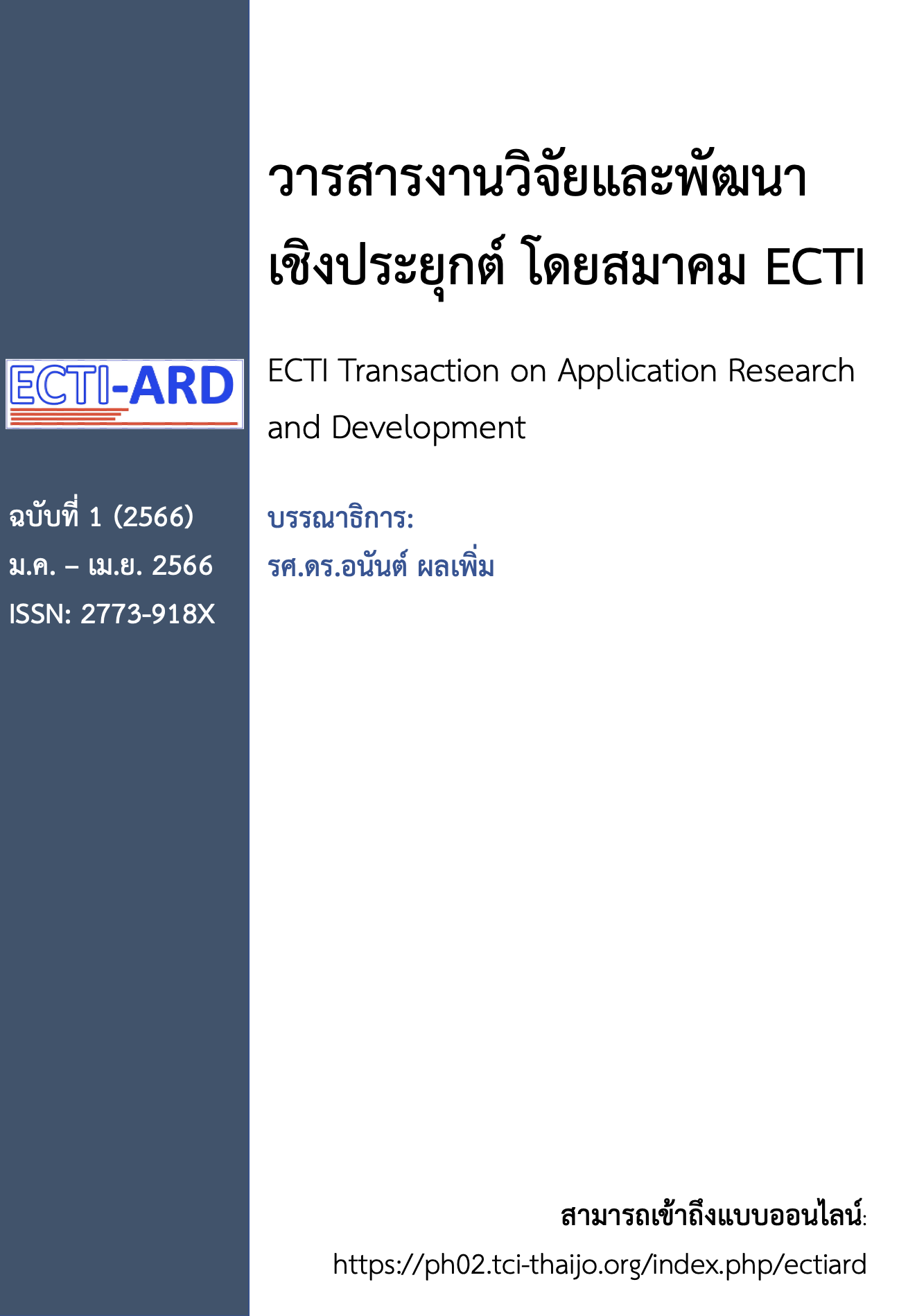การพยากรณ์จำนวนผู้ป่วย COVID-19 ประเทศไทยโดยการใช้ข้อมูลจากหลายประเทศ
Main Article Content
บทคัดย่อ
สถานการณ์โรคระบาดโควิด-19 ได้แพร่กระจายไปทั่วโลกตั้งแต่ปีพ.ศ.2562 การศึกษานี้ได้ทำการพยากรณ์ผู้ป่วยจากโรคโควิด-19ของประเทศไทย โดยใช้ข้อมูลตั้งแต่ วันที่ 22 มกราคม พ.ศ.2563 จนถึงวันที่ 31 ธันวาคม พ.ศ.2564 ซึ่งมีจำนวนข้อมูลอยู่ 710 วัน โดยข้อมูลสาธารณะจากมหาวิทยาลัยจอนส์ ฮอปคินส์ ผู้วิจัยได้ใช้วิธีการเรียนรู้ของเครื่อง (Machine Learning) ในการพยากรณ์จำนวนผู้ป่วยในประเทศเพื่อเป็นหนึ่งในข้อมูลในการช่วยรัฐบาลออกนโยบายการจัดการทรัพยากรเพื่อรับมือกับโรคระบาด การศึกษานี้ได้ใช้วิธีการจัดกลุ่มเคมีน (K-Means) ในการจัดกลุ่มของประเทศที่มีรูปแบบของจำนวนผู้ป่วยจากโรคคล้ายกันกับประเทศไทย ผลจากการจัดกลุ่มมีประเทศที่อยู่ใน Cluster เดียวกันกับประเทศไทยทั้งหมด 8 ประเทศ ได้แก่ ญี่ปุ่น (Japan), มาเลเซีย (Malaysia), ฟิลิปปินส์ (Philippines) ,บังกลาเทศ (Bangladesh) ,คิวบา (Cuba) ,อิรัก (Iraq) ,เม็กซิโก (Mexico) และ เวียดนาม (Vietnam) อยู่ในกลุ่มเดียวกับประเทศไทย จากนั้นทำการจับคู่ระหว่างประเทศไทยและประเทศที่อยู่ในกลุ่มเดียวกัน ใช้โมเดลหน่วยความจำระยะสั้นยาว (Long Short-Term Memory) เพื่อพยากรณ์จำนวนผู้ป่วยโควิด-19 ของประเทศไทย ผลจากโมเดลแสดงได้ว่าการใช้ข้อมูลคู่ประเทศไทยและบังกลาเทศ ญี่ปุ่น และเม็กซิโกมีค่าเฉลี่ยของร้อยละความผิดพลาดสัมบูรณ์ (Mean Absolute Percentage Error) น้อยที่สุดตามลำดับ เมื่อเทียบกับการใช้ข้อมูลแค่ประเทศไทยอย่างเดียว
Article Details

อนุญาตภายใต้เงื่อนไข Creative Commons Attribution-NonCommercial-NoDerivatives 4.0 International License.
เอกสารอ้างอิง
O. L. Aiyegbusi et al., "Symptoms, complications and management of long COVID: a review," Journal of the Royal Society of Medicine, vol. 114, no. 9, pp. 428-442, 2021.
W. H. Organization, "Responding to community spread of COVID-19: interim guidance, 7 March 2020," World Health Organization, 2020.
WHO. (7 June 2022). Archived: WHO Timeline - COVID-19. [Online] Available: https://www.who.int/news/item/ 27-04-2020-who-timeline---covid-19
T. Panch, H. Mattie, and L. A. Celi, "The “inconvenient truth” about AI in healthcare," NPJ digital medicine, vol. 2, no. 1, pp. 1-3, 2019.
P. Warittha, Suchanan, C. (10 June 2022). Tourism at a crossroad. Bank of Thailand. [Online] Available: https://www.bot.or.th/Thai/ResearchAndPublications/articles/Pages/Article_18Aug2021.aspx
T. Mantoro, R. T. Handayanto, M. A. Ayu, and J. Asian, "Prediction of covid-19 spreading using support vector regression and susceptible infectious recovered model," in 2020 6th International Conference on Computing Engineering and Design (ICCED), 2020: IEEE, pp. 1-5.
R. L. Kumar, F. Khan, S. Din, S. S. Band, A. Mosavi, and E. Ibeke, "Recurrent neural network and reinforcement learning model for COVID-19 prediction," Frontiers in public health, vol. 9, 2021.
L. Bi, M. Fili, and G. Hu, "COVID-19 forecasting and intervention planning using gated recurrent unit and evolutionary algorithm," Neural Computing and Applications, pp. 1-19, 2022.
A. Sherstinsky, "Fundamentals of recurrent neural network (RNN) and long short-term memory (LSTM) network," Physica D: Nonlinear Phenomena, vol. 404, p. 132306, 2020.
R. M. Carrillo-Larco and M. Castillo-Cara, "Using country-level variables to classify countries according to the number of confirmed COVID-19 cases: An unsupervised machine learning approach," Wellcome open research, vol. 5, 2020.
D. Abdullah, S. Susilo, A. S. Ahmar, R. Rusli, and R. Hidayat, "The application of K-means clustering for province clustering in Indonesia of the risk of the COVID-19 pandemic based on COVID-19 data," Quality & Quantity, vol. 56, no. 3, pp. 1283-1291, 2022.
V. K. R. Chimmula and L. Zhang, "Time series forecasting of COVID-19 transmission in Canada using LSTM networks," Chaos, Solitons & Fractals, vol. 135, p. 109864, 2020.
S. Dutta and S. K. Bandyopadhyay, "Machine learning approach for confirmation of covid-19 cases: Positive, negative, death and release," MedRxiv, 2020.
A. Tomar and N. Gupta, "Prediction for the spread of COVID-19 in India and effectiveness of preventive measures," Science of The Total Environment, vol. 728, p. 138762, 2020.
C. Xu, "A Comparative Study: Time-Series Analysis Methods for Predicting COVID-19 Case Trend," ed, 2021.
H. Baalbaki et al., "Fighting against COVID-19: Who Failed and Who Succeeded?,", Journal of Computer and Communications, vol. 10, no. 4, pp. 32-50, 2022.
A. B. Said, A. Erradi, H. A. Aly, and A. Mohamed, "Predicting COVID-19 cases using bidirectional LSTM on multivariate time series," Environmental Science and Pollution Research, vol. 28, no. 40, pp. 56043-56052, 2021.
J. MacQueen, "Some methods for classification and analysis of multivariate observations," 1967.
D. Arthur and S. Vassilvitskii, (10 June 2022). k-means++: The Advantages of Careful Seeding, Stanford InfoLab, Technical Report 2006. [Online]. Available: http://ilpubs.stanford.edu:8090/778/
R. C. Staudemeyer and E. R. Morris, "Understanding LSTM--a tutorial into long short-term memory recurrent neural networks," arXiv preprint arXiv:1909.09586, 2019.


